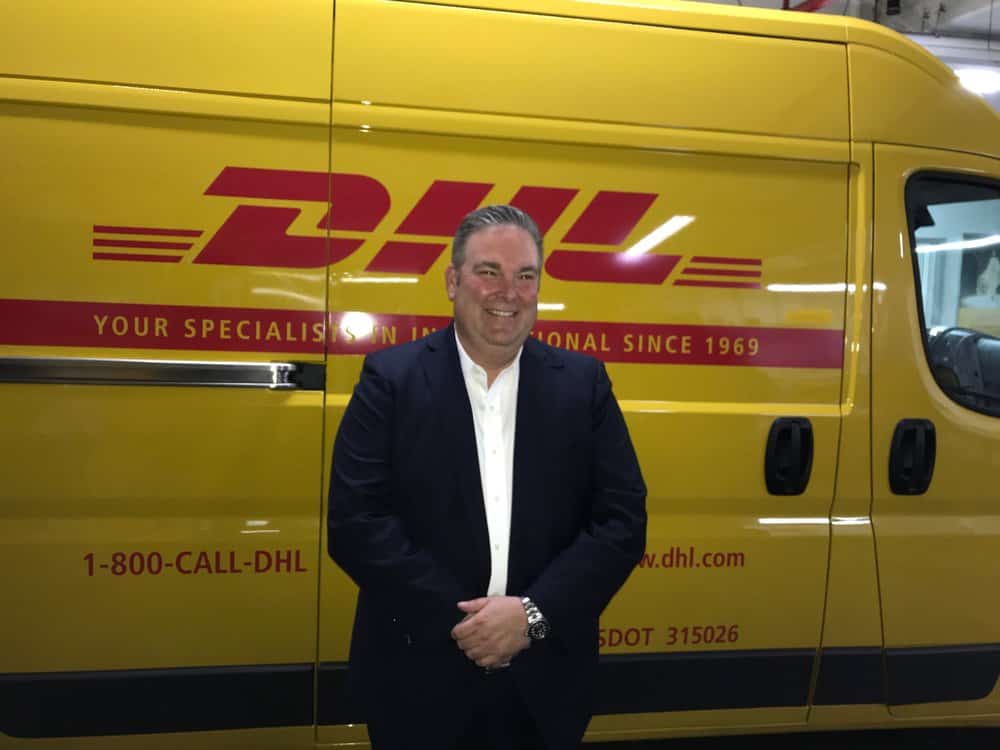The Manhattan multi-level facility of DHL Express would probably look busy any day, particularly in the morning. And it did so on the day after Cyber Monday, when DHL Express invited in the media to discuss market conditions.
The hard data underneath all that activity, according to Greg Hewitt, the president of DHL Express U.S., a subsidiary of Deutsche Post (CSE: DPW.D.IX) is that parcel deliveries through the site were up 15% between Black Friday and Cyber Monday compared to the year before. And that number is close enough to the company’s projected 17% growth in international shipping volumes, Hewitt said, that it sees its forecast for this year as on target.
Fifteen percent, Hewitt said in a one-on-one interview with FreightWaves at the media event, “is not out of line with the 17% estimate.” He also said DHL Express just recorded the biggest day “ever” at its Cincinnati air hub. It also has its biggest peak days ahead of it.
The increase in traffic from the prior quarter is expected to be about 40%, Hewitt said.
DHL Express in the U.S has a unique position. It’s just a delivery point in the company’s international parcel delivery service, with the company having abandoned its quest to become the third major private parcel delivery service–next to UPS and FedEx, but not counting the U.S. Postal Service–in 2009. You can use “Big Yellow” to move a parcel from London to Los Angeles; you can’t use it to move it from San Francisco to Los Angeles.
Almost a decade later, Hewitt said “I am never surprised that I still get the questions when I meet people who say, ‘I thought you guys had left the U.S.'” But there were a number of business-to-business customers back
in 2009 that were aware of what DHL could do internationally, and he called them the “steady backbone” that remained with the company after it pulled out of the intra-domestic parcel business.
What’s helped to overcome that for DHL Express is that ecommerce is completely different now than it was back in 2009. “This globalization trend is different from domestic shipping,” he said. “If you want to buy goods from somewhere overseas or you are a small to medium size business and want to sell things to markets over the world, our network…is a niche and it’s different than getting product in two hours from Secaucus.”

The Manhattan market, the focus of the day’s events, is unique. The DHL center is three stories, unusual for a distribution center, and is located in a former parking garage that had been built with the idea of moving cars in and out of the facility. Now, those ramps and elevators can move DHL trucks on to the streets.
It’s extremely busy early; by noon, New York City area manager Juan Cucalon said, things have quieted down significantly as the first two “waves” of parcels coming in from Kennedy and Newark airports have come in, and shipments have gone out.
Walking through the facility as the media was leaving made that clear, as areas that had been the site of numerous hands working were now mostly empty. But that doesn’t mean nothing is going on. As Hewitt said, “This building has activity throughout the day as we are constantly getting product in to JFK and it is being sent over here.”
The average daily “handle” in Manhattan is 8,000 packages a day, but Cucalon said it handled 20,000 on Cyber Monday.
“The Manhattan market is one that has a lot of sensitivity about early morning deliveries,” Hewitt said. The New York fashion industry, in particular, “is eager to get samples and prototypes for review.” DHL is looking at various steps to implement new practices at JFK airport that would enable it to cut down on the amount of shipments that need to first go through the Cincinnati hub, Hewitt added.
The unique nature of the Manhattan market shows up in different ways. For example, the average driver puts in a grand total of just eight miles over the course of the day. DHL has satellite offices where the couriers make their deliveries by walking. Its fleet is all either electric or hybrids.
Hewitt said DHL is seeing shifts as a result of ongoing or prospective trade wars. There are “big businesses” that are able to shift their output away from Chinese manufacturers–such as semi-conductor and textile companies–and toward places like Vietnam and Thailand. “The good news is that we have strengths and capabilities in all the markets they are looking at,” Hewitt said.
Hewitt said DHL definitely is seeing an increase in activity that appears to be driven by importer desire to get products into markets before a new round of tariffs takes effect January 1. Where higher duties and tariffs are in place, Hewitt said, “unfortunately we are hearing for the smaller and mid-sized businesses that they are finding it harder to recoup those increases in costs.”
DHL took the opportunity of the media day to also announce the launch of DHL On Demand Delivery, which gives greater transparency to customers on where their package is and how they want it delivered. All the power over the shipment in the past, Hewitt said, rested with the shipper, but the new product allows greater customer input. It also will calculate in advance duties and taxes that may need to be paid on the shipment, he added.











